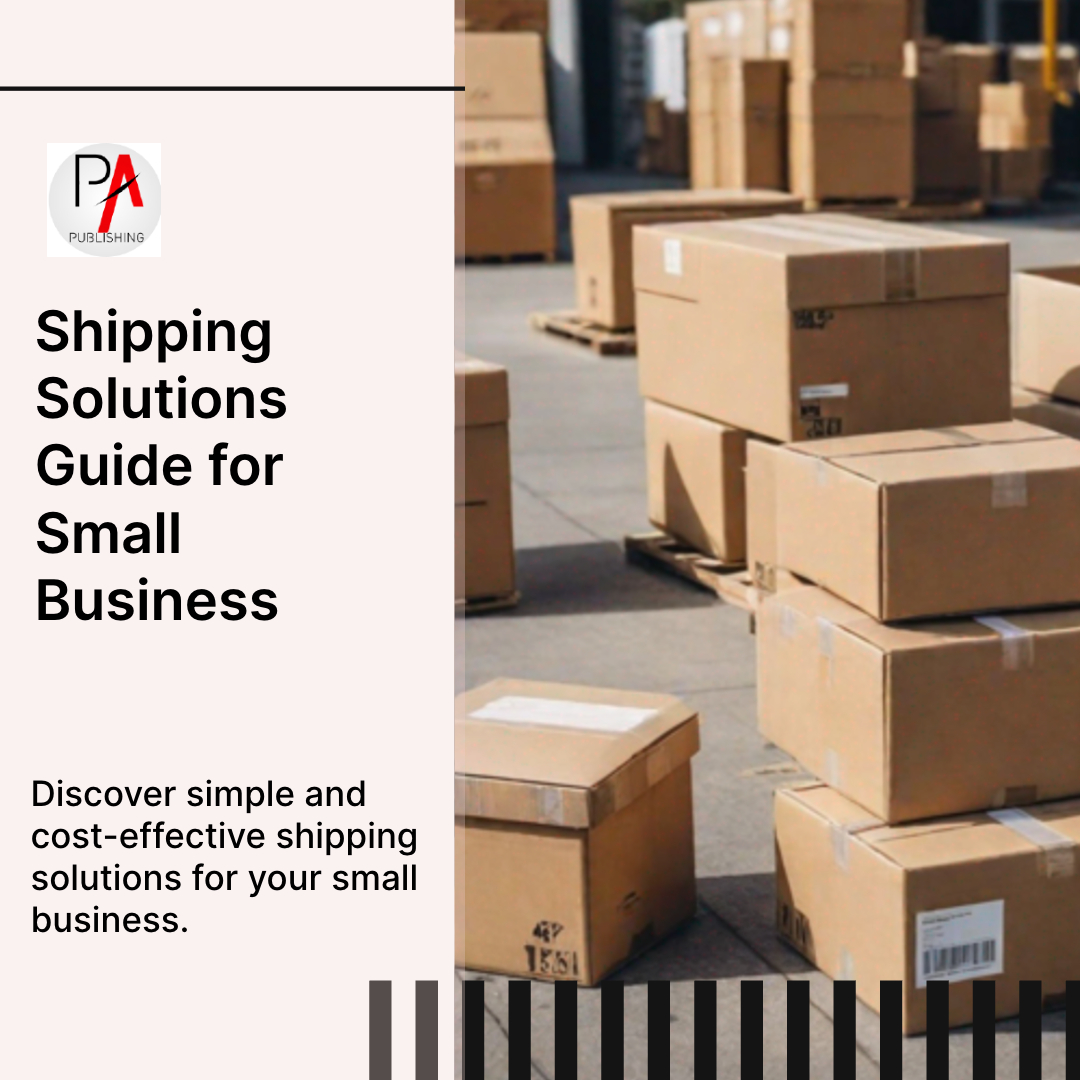Shipping Solutions for Small Business
As a small business grows, navigating the complexities of domestic and international shipping becomes crucial. Understanding the range of delivery speeds and selecting the appropriate services are fundamental steps to streamline operations. This guide aims to equip small business owners with the knowledge to make informed decisions about their shipping strategies, ensuring cost-effectiveness and efficiency.
Unveiling the Core Pillars of Small Business Shipping
Shipping Solutions for Small Business: Small business owners must grasp key concepts such as shipping discounts, dimensional weight, and the use of flat-rate boxes to manage shipping expenses effectively. Whether it’s optimizing the packaging material to showcase your brand or leveraging multiple carriers for better rates, understanding these pillars is essential for successful shipping for small business.
1. Evaluating Carrier Options and Rates
Comparing carrier rates and services is the first step in identifying the best shipping service for your business needs. Each carrier offers unique advantages, and understanding these can help in making an informed decision that aligns with your business objectives and budget.

USPS: A Go-To for Domestic Shipping
For domestic shipments, USPS First Class Mail stands out as a standard choice, offering reliable service at competitive prices. It’s particularly advantageous for small, lightweight packages, making it a preferred option for many small businesses.
FedEx and UPS: Balancing Speed and Costs
FedEx Small Business and UPS offer solutions that balance speed and cost. They are particularly beneficial for businesses that require temperature-controlled shipping, providing specialized services to meet these needs without compromising on delivery times.
DHL: Your Partner for International Reach
When it comes to expanding globally, DHL’s extensive network of fulfillment centers makes it an ideal partner. Their expertise in international logistics can significantly simplify the complexity of reaching customers across borders.
2. Understanding Package Dynamics
Shipping Solutions for Small Business: Grasping the impact of dimensional weight, the use of bubble wrap, and choosing the right carriers typically can help avoid expensive shipping mistakes. A corrugated box that protects the product while minimizing size can be crucial for cost-effective shipping.
Package Weight: A Decisive Factor in Shipping Costs
Shipping discounts and favorable carrier rates are more accessible when businesses optimize shipping strategies around package weight. A focus on keeping packages light can influence the choice of shipping service, leading to significant savings.
Package Dimensions: How Size Affects Your Options
Using bubble wrap effectively allows for better protection of items while managing the package’s dimensions. Smaller, well-protected packages often qualify for lower shipping rates, emphasizing the importance of thoughtful packaging.
3. Mastering the Shipping Zone Maze
Shipping Solutions for Small Business: Understanding how the distance a package travels impacts shipping rates with carriers is essential. Navigating this maze can uncover opportunities to save money by optimizing shipping zones.
The Impact of Shipping Destination on Rates
Utilizing flat-rate boxes can be a strategic choice to save money on shipping, especially for long-distance deliveries. These options provide standard pricing, making it easier to predict shipping costs regardless of the destination.

4. Optimizing Order Volume and Delivery Time
Shipping Solutions for Small Business: Efficiently managing the printing of labels and handling orders you ship through a DIY route or ecommerce fulfillment can significantly impact delivery times. Streamlining these processes ensures orders are dispatched swiftly, enhancing customer satisfaction.
Strategies for Handling Varied Order Volumes
Adapting to fluctuating order volumes requires flexible strategies. Whether it’s scaling up operations during peak seasons or maintaining efficiency with lower volumes, businesses must be agile to meet customer demand without compromising on delivery times.
Setting Realistic Delivery Time Expectations with Customers
Communicating shipping timeframes transparently with customers sets realistic expectations. This transparency helps build trust, ensuring customers are informed about when they can anticipate receiving their orders.
Reducing Costs While Enhancing Efficiency
Shipping Solutions for Small Business: Every small business aims to save money on shipping while enhancing operational efficiency. Through strategic choices in packaging, carrier selection, and leveraging technology, businesses can achieve significant savings without sacrificing the quality of their shipping services.
1. Smart Packaging Choices
Making smart packaging choices is essential for small businesses aiming to showcase their brand while managing costs. By selecting packaging materials that are both affordable and reflective of the brand’s image, businesses can create a memorable unboxing experience for customers. Custom packaging, though sometimes more costly, can serve as a marketing tool, reinforcing brand recognition and loyalty. Weighing the benefits of custom packaging against the costs is a crucial step in optimizing a small business’s shipping strategy.
Choosing Affordable Packing Materials
Minimizing shipping expenses begins with choosing affordable packing materials. Cost-effective packaging doesn’t mean compromising on quality; it’s about finding the right balance. Businesses should consider lightweight and durable materials that protect the product while keeping costs down. This approach not only reduces the shipping fees but also aligns with environmentally conscious practices by potentially using less material.
Leveraging Free Shipping Supplies from Carriers
Many carriers, including UPS and FedEx, offer free shipping supplies, which can significantly reduce overhead costs. These supplies often include boxes, envelopes, and even specialty items like dry ice for shipping perishables. By taking advantage of these free resources, small businesses can allocate more funds towards other operational areas, improving overall efficiency and cost-effectiveness.
2. Navigating Shipping Costs with Savvy Tactics
Shipping Solutions for Small Business: Small businesses can optimize shipping by understanding carrier rates, shipping service options, and how to manage shipping volume effectively. Implementing cost-effective shipping strategies and streamlining the shipping process are key to maintaining profitability. By analyzing these elements, businesses can identify opportunities to reduce costs while ensuring timely deliveries.
Negotiating Rates for Better Deals
Negotiating with carriers can lead to significant savings, especially for shipping for small business entities that regularly ship 100 orders or more. Building a strong relationship with carriers can open the door to discounted rates, customized to the business’s specific shipping volume and needs. This proactive approach can markedly reduce shipping costs over time.
Harnessing Shipping Discounts: USPS, UPS, and DHL Express Offers
Utilizing shipping discounts from major carriers like USPS, UPS, and DHL Express can help grow your business by reducing overhead costs. These carriers often provide discounted rates for businesses that ship in high volumes or use their shipping services exclusively. Staying informed about current offers and promotions can yield substantial savings, making these services more accessible to small businesses.
3. Streamlining Operations through Technology
Shipping Solutions for Small Business: Embracing technology can significantly streamline shipping and fulfillment processes, making operations more efficient and cost-effective. From rate comparison tools to shipping automation software, technology offers solutions that can save time and reduce errors, leading to a smoother operation and improved customer satisfaction.
Rate Comparison Tools: Finding the Best Deals
Rate comparison tools are invaluable for finding the best shipping deals. By allowing businesses to compare rates across different carriers quickly, these tools help identify the most cost-effective shipping options for various package sizes, weights, and destinations. This ensures that businesses are not only saving money but also choosing the right service level for their needs.
Embracing Shipping Automation for Quicker Fulfillment
Shipping automation software can transform the shipping and fulfillment process, making it quicker and more reliable. By automating tasks such as label printing, tracking updates, and customer communications, businesses can reduce manual errors and free up time to focus on growth and customer service. This investment in technology pays off through increased efficiency and customer satisfaction.
Shipping Services That Cater to Small Business Needs
Shipping Solutions for Small Business: Small businesses require shipping services that can provide a version of small business shipping that balances affordable rates with efficient and reliable delivery options. Streamlining shipping processes is essential for these businesses, as it allows them to compete more effectively in the marketplace and meet customer expectations for prompt, cost-effective deliveries.
1. Deciphering the Best Shipping Services
Finding the best shipping services for a small business involves considering factors like loyalty credits, options for same-day delivery, and overall affordable shipping rates. These elements help businesses enhance customer satisfaction and loyalty, which are critical for long-term success. Choosing the right shipping service can make a significant difference in a small business’s operational efficiency and profitability.
Standard vs. Expedited Shipping: Making the Right Choice
Deciding between standard and expedited shipping involves weighing the cost against the delivery speed. Standard shipping is more affordable and suitable for non-urgent deliveries, while expedited shipping offers faster delivery times at a higher cost. Understanding customer expectations and order priorities can help businesses make the right choice, balancing cost and customer satisfaction.
The Advantage of Flat Rate Shipping for Predictable Costs
Flat rate shipping offers the advantage of predictable costs, simplifying budgeting for businesses. This shipping option allows businesses to send packages of a certain size and weight for a fixed price, regardless of the destination. It’s particularly beneficial for businesses with consistent shipping needs, offering cost savings and streamlined logistics.
2. Multi-Carrier Strategies: Balancing Cost and Service
Employing a multi-carrier strategy allows businesses to balance cost and service by leveraging the strengths of different carriers for various shipping needs. This approach offers flexibility and can lead to better rates and service options, enhancing overall shipping efficiency and customer satisfaction.
The Flexibility of Using Multiple Carriers
Using multiple carriers provides businesses with the flexibility to choose the best shipping option for each package, based on factors like cost, delivery speed, and destination. This strategy can help businesses optimize shipping costs and improve delivery times, contributing to a better customer experience and stronger business performance.
Gaining More Negotiating Power with Carriers
Small businesses can enhance their negotiating power with carriers by understanding their service options and volume needs. By presenting carriers with consistent volume and a clear grasp of required service options, small businesses can negotiate better rates. This approach demonstrates to carriers the potential for a long-term partnership, making them more open to offering competitive rates and service agreements tailored to the small business’s specific needs.
3. International Shipping: Expanding Your Reach
Expanding internationally allows small businesses to grow their business beyond local borders. DHL Express, known for its reliable express shipping, can help businesses navigate the complex landscape of international shipping. They offer competitive shipping prices, making it easier for small businesses to reach new markets without breaking the bank.
Understanding International Shipping Costs
International shipping costs can vary widely based on destination, package size, and weight. Factors like customs duties and taxes also play a significant role in the final cost. Small businesses should familiarize themselves with these variables and consider them when setting prices for international customers. This understanding can help in making more informed decisions about which markets to enter and how to price products for international sale.
Fastest and Cheapest Options for Global Expansion
When looking to expand globally, small businesses should consider both the speed and cost of shipping. While express shipping options like DHL Express offer rapid delivery, they may come at a higher cost. On the other hand, standard shipping options can be more cost-effective but take longer. Businesses should weigh these options against customer expectations and order urgency to find the right balance for their international expansion strategy.

Beyond Shipping: Bolstering Your Business with Additional Insights
Shipping Solutions for Small Business: Going beyond mere shipping logistics can significantly enhance small business growth. By diving deeper into market trends, customer preferences, and operational efficiencies, businesses can identify new opportunities for improvement and expansion. This holistic approach ensures that every aspect of the business is aligned towards achieving sustainable growth.
1. Protecting Shipments and Bottom Line
Using USPS First Class Mail for shipping smaller, lightweight items can be a cost-effective option. However, adding third-party insurance can further protect against losses, ensuring that the business’s bottom line remains secure. This combination offers both affordability and peace of mind.
The Role of Third-Party Insurance in Cost Reduction
Third-party insurance offers competitive rates compared to carrier-provided options, allowing small businesses to reduce shipping costs while still protecting their shipments. This cost-saving measure does not sacrifice security, ensuring that businesses can confidently ship products knowing they’re covered against loss or damage.
2. Tailoring Shipping to Ecommerce Success
Successful ecommerce relies on more than just selling products online. It requires a strategic approach to shipping that aligns with customer expectations and business goals. By optimizing shipping strategies, businesses can enhance customer satisfaction and drive repeat business.
Ecommerce Shipping Best Practices for Sales Growth
Shipping Solutions for Small Business: Implementing best practices for ecommerce shipping can significantly impact sales growth. Offering a variety of shipping options, including free shipping thresholds, can attract more customers. Transparent communication about shipping times and costs helps build trust. Additionally, easy return policies can encourage purchases by reducing buyer hesitation.
Building a Loyal Following Through Ecommerce Branding
Consistency in packaging and branding across all shipments can help connect ecommerce experiences with the brand, fostering customer loyalty. Including personalized touches in orders or special packaging can enhance the unboxing experience, making customers more likely to return and recommend the brand to others.
3. Leveraging Discounts and Consolidation for Savings
Small businesses can achieve significant savings by leveraging discounts and consolidation strategies. This approach can drastically reduce shipping costs, making it easier to manage expenses and improve profit margins.
LTL Freight and Shipping Consolidator Discounts
Using Less Than Truckload (LTL) freight options and shipping consolidators can offer discounts for small businesses. These services combine shipments from multiple businesses into one, reducing overall shipping costs. This method is especially beneficial for businesses with smaller volumes that do not require a full truckload.
Insurance Shipping Discounts: A Cost-Effective Alternative
Securing insurance through shipping consolidators or third-party providers can offer more affordable rates than carrier insurance. These discounts can significantly lower the cost of insuring shipments, making it a cost-effective strategy for protecting goods in transit without impacting the bottom line.
Crafting Your Optimal Shipping Strategy
Shipping Solutions for Small Business: Creating an optimal shipping strategy involves leveraging technology to compare rates online and adopting multi-carrier shipping to meet various needs. This approach allows small businesses to select the most cost-effective and efficient shipping options, enhancing customer satisfaction and maintaining competitive edge.
Key Considerations for Small Businesses
Small businesses must consider multiple factors when developing their shipping strategy. Understanding the balance between shipping costs, delivery times, and customer expectations is crucial. By focusing on these key areas, businesses can create a shipping strategy that supports growth and customer satisfaction.
Leveraging Technology for Savings and Efficiency
Small businesses thrive by maximizing efficiency, and leveraging technology is a keystone in this pursuit. Shipping software that supports multi-carrier shipping options can dramatically streamline operations. It allows businesses to compare rates and services across multiple carriers in real time. This not only ensures the best deals but also simplifies inventory management. By automating these processes, small businesses save valuable time and resources, which can be better spent on other areas of operation.
Automating Customs Compliance to Save Time and Money
For businesses shipping internationally, navigating the complexities of customs can be daunting and time-consuming. Automating the customs compliance process is a strategic move to reduce both time and expenses. By utilizing software that automatically fills out necessary customs documentation and ensures compliance with international shipping regulations, businesses can avoid costly delays. This automation helps in maintaining a smooth flow of goods across borders, making international shipping less intimidating for small businesses.
The Path Forward: Navigating Small Business Shipping Solutions
Shipping Solutions for Small Business: As a business grows, the shipping strategy must evolve to meet the dynamic demands of both domestic and international markets. Utilizing a shipping calculator and understanding the nuances of delivery speeds, such as next-day delivery, can give small businesses a competitive edge. Negotiating discounted rates from shipping companies for small businesses and choosing the optimal shipping method based on comprehensive insights into retail rates are critical steps. These practices ensure that businesses can offer customers the best rates for small orders without compromising on service quality.
Conclusion: Mastering Shipping Solutions for Sustainable Growth
For small businesses aiming at sustainable growth, mastering efficient shipping solutions is non-negotiable. Utilizing Priority Mail Express International and other cost-effective shipping materials are strategies that not only market your business effectively but also play a significant role in growing your business. It’s about making informed decisions that contribute to both short-term success and long-term viability.
Adopting a Holistic View of Shipping Solutions
Adopting a holistic view of shipping solutions means understanding the interconnectedness of various shipping aspects. From selecting the right packaging to choosing the best carrier for specific needs, every decision impacts the overall efficiency and cost-effectiveness of shipping. It involves a strategic analysis of shipping practices, leveraging technology for better inventory management, and optimizing the use of multiple carriers to ensure the most favorable rates and services. This comprehensive approach enables small businesses to navigate the complexities of shipping with confidence and agility.
The Journey Towards Cost-Effective and Efficient Shipping
The journey towards cost-effective and efficient shipping is ongoing and requires constant adaptation. It starts with a clear understanding of the fundamental shipping needs of the business and expands to include sophisticated strategies such as automating customs compliance and streamlining operations through technology. By continuously seeking ways to improve and by staying informed about the latest shipping solutions, small businesses can ensure they remain competitive. Ultimately, the goal is to achieve a balance where shipping contributes positively to growth without becoming a burdensome expense.

